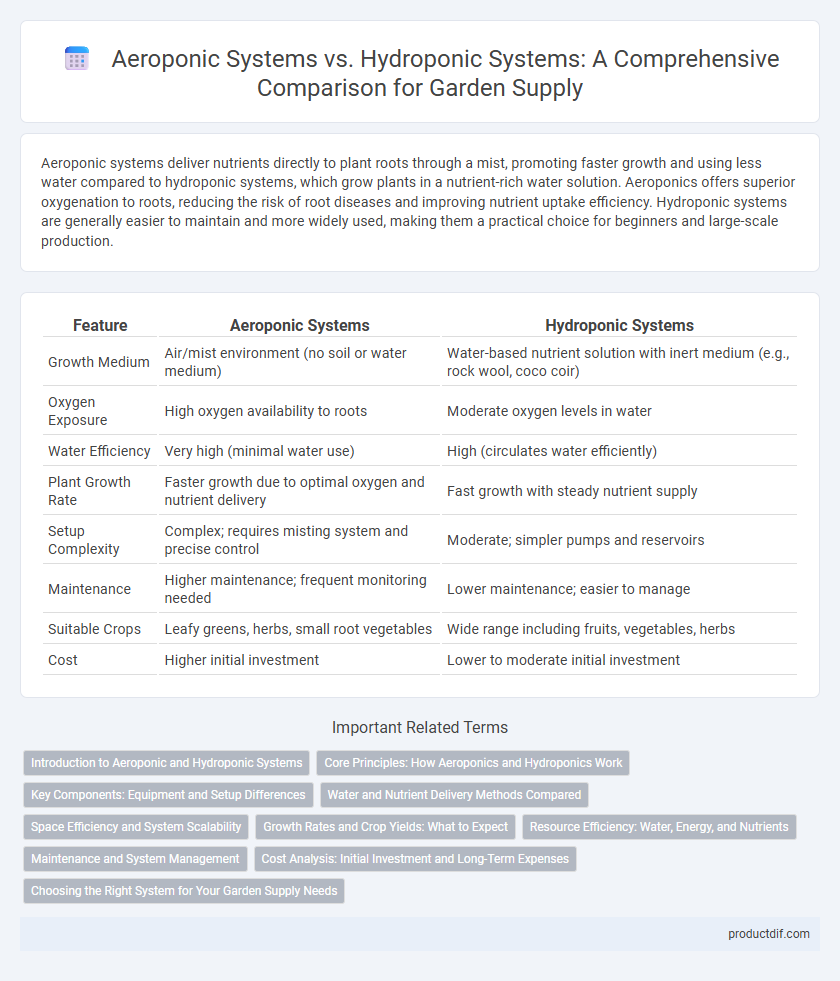Aeroponic systems deliver nutrients directly to plant roots through a mist, promoting faster growth and using less water compared to hydroponic systems, which grow plants in a nutrient-rich water solution. Aeroponics offers superior oxygenation to roots, reducing the risk of root diseases and improving nutrient uptake efficiency. Hydroponic systems are generally easier to maintain and more widely used, making them a practical choice for beginners and large-scale production.
Table of Comparison
| Feature | Aeroponic Systems | Hydroponic Systems |
|---|---|---|
| Growth Medium | Air/mist environment (no soil or water medium) | Water-based nutrient solution with inert medium (e.g., rock wool, coco coir) |
| Oxygen Exposure | High oxygen availability to roots | Moderate oxygen levels in water |
| Water Efficiency | Very high (minimal water use) | High (circulates water efficiently) |
| Plant Growth Rate | Faster growth due to optimal oxygen and nutrient delivery | Fast growth with steady nutrient supply |
| Setup Complexity | Complex; requires misting system and precise control | Moderate; simpler pumps and reservoirs |
| Maintenance | Higher maintenance; frequent monitoring needed | Lower maintenance; easier to manage |
| Suitable Crops | Leafy greens, herbs, small root vegetables | Wide range including fruits, vegetables, herbs |
| Cost | Higher initial investment | Lower to moderate initial investment |
Introduction to Aeroponic and Hydroponic Systems
Aeroponic systems deliver nutrient-rich mist directly to plant roots suspended in air, promoting faster growth and efficient oxygen absorption, while hydroponic systems grow plants in nutrient-infused water solutions that support root development without soil. Aeroponics offers a soil-free environment with higher oxygen exposure, which can lead to increased yield and resource conservation. Hydroponics provides a stable, water-based growing medium that simplifies nutrient management and is widely used for various crops in controlled environments.
Core Principles: How Aeroponics and Hydroponics Work
Aeroponic systems deliver nutrient-rich water as a fine mist directly to plant roots suspended in air, maximizing oxygen exposure and promoting rapid growth. In contrast, hydroponic systems submerge roots in nutrient-enriched water or a moist medium, ensuring constant hydration and nutrient availability. Both systems optimize resource use and growth efficiency but differ in root aeration and water delivery methods.
Key Components: Equipment and Setup Differences
Aeroponic systems rely on misting nozzles, high-pressure pumps, and enclosed root chambers to deliver nutrient-rich air, while hydroponic systems use water reservoirs, submersible pumps, and growing trays or channels to submerge roots in nutrient solutions. Aeroponic setups require precise control of misting intervals and air circulation for optimal oxygenation, contrasting with hydroponic setups that emphasize maintaining proper water pH, temperature, and nutrient concentration. Both systems necessitate monitoring equipment, but aeroponics demands more advanced technology to ensure adequate mist distribution and prevent root dehydration.
Water and Nutrient Delivery Methods Compared
Aeroponic systems deliver nutrients and water by misting plant roots with a fine spray, maximizing oxygen exposure and promoting rapid growth while using less water compared to hydroponic systems. Hydroponic systems submerge roots in a nutrient-rich water solution or use a medium to support plants, providing a more constant nutrient supply but with higher water consumption. Both systems optimize nutrient uptake efficiency, but aeroponics offers superior oxygenation and reduced water usage, making it ideal for water-conservation-focused gardening.
Space Efficiency and System Scalability
Aeroponic systems maximize space efficiency by suspending plant roots in air, enabling higher density planting compared to hydroponic systems that use water channels or trays. The scalability of aeroponic systems is often more flexible due to modular components that can be vertically stacked, whereas hydroponic setups typically require larger horizontal footprints. For urban gardening or limited-space environments, aeroponics provides superior vertical scalability and resource optimization.
Growth Rates and Crop Yields: What to Expect
Aeroponic systems deliver up to 30% faster growth rates compared to hydroponic systems due to enhanced oxygen availability to plant roots. Crop yields in aeroponics can increase by 20-25% as roots receive optimal nutrient misting, promoting superior nutrient absorption. Hydroponic systems remain effective but generally show slightly slower growth and marginally lower yields when compared to advanced aeroponic setups.
Resource Efficiency: Water, Energy, and Nutrients
Aeroponic systems use up to 90% less water than hydroponic systems by delivering nutrients through mist directly to plant roots, significantly reducing water waste. Energy consumption in aeroponics tends to be higher due to the need for high-pressure pumps, but nutrient efficiency improves as the closed-loop system allows precise nutrient control and minimal runoff. Hydroponic systems, while using more water, often consume less energy and provide stable nutrient delivery, making them efficient for larger-scale production with consistent resource management.
Maintenance and System Management
Aeroponic systems require regular monitoring of mist nozzles to prevent clogging and ensure consistent nutrient delivery, often demanding more precise maintenance schedules compared to hydroponic systems. Hydroponic setups typically involve managing water quality and nutrient concentration in reservoirs, with routine cleaning to avoid algae buildup and root diseases. Both systems benefit from automated controls for pH, nutrient levels, and environmental factors, but aeroponics generally requires more attentive system management due to its intricate misting requirements.
Cost Analysis: Initial Investment and Long-Term Expenses
Aeroponic systems typically require a higher initial investment due to advanced technology and specialized equipment compared to hydroponic systems. Long-term expenses for aeroponics can be lower because they use less water and nutrients, enhancing efficiency and reducing operational costs. Hydroponic systems often incur moderate upfront costs but may experience higher maintenance expenses from water usage and potential system clogging.
Choosing the Right System for Your Garden Supply Needs
Aeroponic systems deliver nutrients by misting plant roots in an oxygen-rich environment, offering faster growth rates and reduced water usage compared to hydroponic setups, which suspend roots in nutrient-rich water. For garden supply needs prioritizing space efficiency and high yield, aeroponic systems are ideal, while hydroponic systems suit larger operations favoring simplicity and lower initial costs. Considering factors like crop type, budget, and maintenance capabilities ensures selecting the optimal system for sustainable and productive gardening.
Aeroponic systems vs Hydroponic systems Infographic

 productdif.com
productdif.com